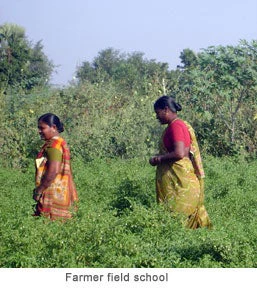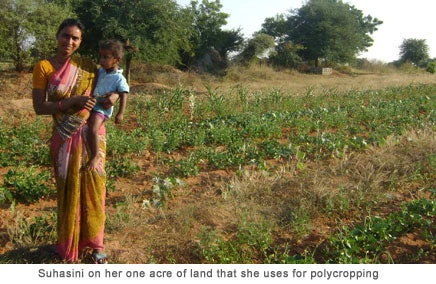A tiny green oasis stands out amidst acres of dry arid land. As many as 12 different crops—including a wide variety of pulses, fruits, vegetables, and flowers—as well as a farm pond constructed through the Employment Guarantee Scheme and a vermicomposting pit are all seen on this one acre farm in the drought-ridden village from Warangal district of Andhra Pradesh. Suhasini, a young Dalit woman who decided to experiment with the only acre (0.4 hectares) of land she owned, asserts confidently “Next year, most of this surrounding land would be green as well—the other farmers will definitely follow me.”
Suhasini is one among over 1.2 million farmers across 9000 villages that are practicing a cheaper and more sustainable method of agriculture across 1.2 million hectares in the state, even as more farmers are becoming part of what is termed a farmers’ movement for sustainable agriculture in Andhra Pradesh. The program named Community Managed Sustainable Agriculture (CMSA) is essentially an alternative to the conventional-input intensive-agriculture model. It promotes the use of locally available, organic external inputs—including cow dung, chickpea flour, and palm sap—and the use of traditional organic farming methods such as polycropping and systems of rice intensification (SRI).
The key reason for the success behind this program compared to similar initiatives by the Government of India is the fact that the entire program is led, supported, and monitored by the 930,000 self-help groups (SHGs) of poor, rural women across the state. This platform of women’s community institutions is the result of over 11 years of work by the Society for Elimination of Rural Poverty (SERP), a state-government support structure, aided by the World Bank, with a mandate of rural poverty eradication through social mobilization and empowerment of poor, rural women.
Climate change, as an issue, is often imagined as being the realm of the academic and policy making elite. However, a single visit to any of the CMSA villages in Andhra Pradesh would dispel this assumption. Women discuss, with both simplicity and clarity, how the recent increase in temperatures and lower rainfall has been depleting the basic resources for rural life—soil, water, fodder, and food. In fact, they confess that they themselves are possibly responsible for this state of affairs. Lakshmi, an SHG member in Chinnaramachella village elaborates, “Since the Green Revolution in 1960s, we discarded our earlier techniques of organic farming and started practicing methods such as mono-cropping and excessive use of pesticides in the hope of higher yields and better profits. We have now realised that this depleted the ‘health’ of our soil.” Small and marginal farmers, some owning as little as half an acre, were the worst hit by the crop failures leading to a huge debt crisis for farmers in the state.

Surprisingly, it was not only the promise of better profits that attracted the Andhra women to CMSA. The key reason, in fact, was the growing concern with health and nutrition. With entire farms being devoted to rice, sesame, maize, or cotton production, green vegetables and fruits remained inaccessible to most families due to scarcity in local markets and high prices. With recurrent exposure to harmful pesticides, women particularly suffer from a number of ailments. The women point out the problem in a very simple statement, “My mother and mother-in-law are much healthier compared to me. This worries me since I know that the next generation—my children—will enjoy even lesser health since they don’t have access to even half the quality of nutritious food I received in my childhood.” In fact, some of the women also reported that they noticed that pesticide-free fodder was much more palatable to the cattle they reared. The women thus upheld the health and nutrition agenda while motivating entire villages to move to the CMSA model.
Of course, the women claim that the journey has not been easy. Agriculture in India, although female-labour intensive, continues to be a male-dominated occupation with key decisions being made by men. However, there have been inspiring examples such as that of the 19-year-old tribal girl Meenakshi. She won a bet against her husband where each partner cultivated half the land owned by them during one season with their respective farming methods—conventional versus CMSA, and the family would shift to whichever method made more profit. Of course Meenakshi won the bet with a margin of Rs. 5000 and today the couple has been featured in the Forbes Magazine as best practitioners.
The vision for the CMSA program is that by 2020, women’s institutions shall manage and run the CMSA covering eight million farmers across 80% of the cultivable land. They are determined to ensure that villages make every effort to preserve the few natural resources that are significant to their very existence.



Join the Conversation